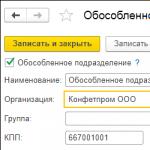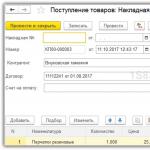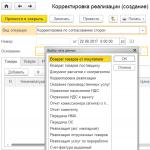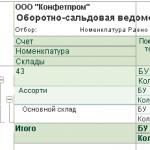How to add a separate division in 1C 8.3. Structure of the enterprise (division) in 1C: Trade Management
08.09.2016
To create a separate division, the taxpayer must fulfill a number of obligations in accordance with the legislation of the Russian Federation. These include the need to register with the tax authorities, calculation and payment of taxes/fees both at the location of the enterprise and at the location of separate divisions / Art. 19 Tax Code of the Russian Federation/.
According to paragraph 2 of Art. 23 of the Tax Code of the Russian Federation, the taxpayer is obliged to notify the tax authority about the creation of a separate division, paragraphs 1 and 4 of Art. 83 of the Tax Code of the Russian Federation regulate the need for registration with the tax authorities at the location of the separate division. Please note that if the taxpayer is already registered with one of the tax authorities, there is no need to register with the same tax authority, but on a different basis / paragraph 39 of the resolution of the Plenum of the Supreme Arbitration Court of Russia dated February 28, 2001 No. 5 “On some issues of application of part first of the Tax Code of the Russian Federation"/.
In Articles 23 and 83 of the Tax Code of the Russian Federation you can find information about the deadlines for filing an application for tax registration at the location of a separate division:
Taking into account the information that when registering a taxpayer for tax purposes when creating a separate division, it is necessary to focus on the location of the division. Thus, a corresponding application is submitted to the tax authority, taking into account the territorial jurisdiction, while the specifics of accounting for private groups in specialized tax authorities are not taken into account. Specialized groups include tax authorities of an industry or subject area (construction, motor transport, etc.). This conclusion is confirmed by the special provisions of the Tax Code of the Russian Federation, which provide for the distribution of tax obligations, including the location of the designated separate divisions. Because part of the tax obligations is usually distributed to the budgets of additional territories, we can conclude that there are territorial bodies involved in monitoring the payment of taxes in the specified territory.
However, it is impossible to make an unambiguous interpretation of the term “separate division”, which, within the framework of tax legal relations, should lead to the mandatory payment of taxes by the taxpayer to various budgets of the constituent entities of the Russian Federation or municipalities. Otherwise, the peculiarity of a separate division will consist only in territorial isolation, and therefore the amount of the taxpayer’s tax obligations will remain unchanged. The courts did not recognize this argument as fair, despite its apparent logic.
When making a transaction with a separate division, you must enter both values in the directory of counterparties: legal entity - head division and separate division.
To add a separate division to the directory, you must select the “Separate division” type, then select an element in the directory of counterparties that corresponds to the legal entity (head division), and also enter the checkpoint and address of the separate division.
Then, in order to formalize a transaction with a counterparty - a separate division - in the sales/receipt document, in the “Counterparty” field, you must indicate the element of the directory of counterparties corresponding to the legal entity - the head division, in the “Consignee” field - a separate division.
Legal entities have the right to create separate divisions for various purposes. The legislation regulates in detail the conditions and procedure for their creation. Separate divisions simultaneously have two main characteristics:
- The address of a separate division differs from the address of the organization indicated in the Unified State Register of Legal Entities;
- At the location of the separate unit, at least one stationary workplace is equipped for a period of more than a month.
In the 1C:Accounting 3.0 program, created on the 1C:Enterprise 8.3 platform, registration of a separate division is carried out in the menu “Directories - Enterprises - Divisions”.
Fig.1
You need to create a new division in 1C: check the “Separate division” box, fill in all the details, indicate the head division. The division will have its own checkpoint, and the TIN will be common for all divisions and the parent company.

Fig.2
After filling out, the document must be recorded, and then it will be reflected in accounting.

Fig.3
In the 1C program, you can create, configure and maintain records of several organizations and departments at the same time. At the same time, it is possible to separately calculate wages with the submission of tax reports to different Federal Tax Service Inspectors. Let's look at an example of how to keep records for separate divisions in terms of wages.
In the main menu, select “Administration – Program settings – Accounting parameters”.

Fig.4
In the accounting parameters, select “Salary settings”.

Fig.5
In the “Payroll calculation” section, check the “Payroll calculation by separate departments” checkbox.

Fig.6
In the department card you can enter the details of the tax office to which the reports will be submitted.

Fig.7
Payroll
First, we need to hire employees for our division. To do this, go from the main menu to “Salaries and personnel – Personnel records – Hiring”.

Fig.8
Through “Create” we go to the employment document. We fill in the following information:
- The organization is our organization;
- Division – a separate subdivision;
- Position – position of an employee of a separate unit;
- Employee – an employee of a separate unit;
- Reception date – fill in the required date;
- Probation period – fill in if one is provided;
- Type of employment – in our case it is internal part-time work.

Fig.9
Now let’s calculate the salary of the employee of the main and separate division. Salaries in 1C 8.3 are calculated in the section “Salaries and Personnel - Salaries - All Accruals”.

Fig.10
Using the “Create” button, we calculate wages for employees of the main department. For example, let's take data for one employee. We will fill out and post the “Payroll” document.


Fig.12
Generation of 2-NDFL certificates
So, we have calculated wages for two employees of the main and separate departments. Next, we will generate 2-NDFL certificates for these employees. To do this, from the main menu go to “Salaries and personnel – personal income tax – 2-NDFL for transfer to the Federal Tax Service”.

Fig.13
We create a certificate for an employee of the main department. The 1C 8.3 program offers the opportunity to select a tax office according to OKTMO and KPP. We select the one we need and fill in the remaining data. The employee data should be filled in automatically. The help displays the following information:
- The tax rate is in our case 13%;
- Income – accrued salary to an employee;
- Taxable income - if there were no deductions, then the amounts are the same;
- Tax – the amount of accrued personal income tax;
- Withheld - personal income tax is withheld at the time of salary payment, our salary has only been accrued, so in our case the value in this cell is “0”;
- Listed – this field will be filled in after the tax is paid to the budget, so for now it is also “0”.


Fig.15
Next, fill out a certificate for an employee of a separate unit. We generate the certificate in a similar way, changing the data in the OKTMO/KPP field when paying income. Data from the Federal Tax Service at the address of the separate division. Similar to the previous certificate, the employee’s data, his income, tax rate and tax amount are filled in automatically.

Fig.16
Just like for the previous certificate, you can display a printed form in which we see the Federal Tax Service code different from the first one.

Fig.17
In this article, we looked at how to create a separate division, as well as the possibilities offered by the 1C 8.3 program for payroll, tax calculation, as well as submitting reports for employees of the main and separate divisions to different tax inspectorates. Thanks to them, maintaining a separate unit in the program will not be difficult for users.
31.05.2018 17:59:55 1C:Servistrend ru
Registration of a new division in the 1C program: Accounting 8.3
The “Divisions” directory is used in all sections of accounting, acts as analytics in many accounting and tax accounts and is one of the key objects of the system. In this article we will look at the features of adding a new division to the organization structure in the program.
The initial filling of the directory is carried out when the program is put into commercial operation, along with other regulatory and reference information. Subsequent changes are made in accordance with the orders of the enterprise.
For internal accounting purposes, organizations issue an order to introduce a new division (cost center). Next, the documents are sent to the person responsible for setting up and adding regulatory and reference information. Having received the document, the user follows the navigation path to create a new division: Directories / Enterprise / Divisions.
In the open form of the directory element “Divisions”, the person responsible for setting up master data fills in the following fields:
- Name – custom name of a department or group of departments;
- Organization – fill in the current organization;
- Group – indicates the element that is the parent in the structure.

The directory of departments is hierarchical; there is a division into elements and groups. The user is given the opportunity to build a structure of divisions containing up to 10 nesting levels. To move units to a new group, the user can specify the required value in the “Group” field on the card.

To use a department as the main one in documents, you need to click the “Use as main department” command in the form of the list of departments.

It is worth noting that the directory of departments reflects the structure of the organization for personnel records, calculation and reflection of salaries, accounting and tax accounting, etc. Thus, it is recommended to fill out this directory based on the actual structure of the enterprise, also taking into account the groupings of divisions in the context of which it is necessary to build reports.
Organizations should also establish procedures for renaming and closing departments in accordance with accounting needs. When closing, information about the current status and closing date can be added to the name of the unit for convenience and to prevent errors by users. When renaming a division, the options are to change the name on the card or create a new division in the structure.
Still have questions? We'll tell you about adding divisions to 1C as part of a free consultation!
Directories "Employees of the organization", "Divisions of the organization", "Organization positions"are the main ones on the basis of which the entire structure of the enterprise is formed.
Basic information about the company can be entered in the directory "Organizations".
To call this directory, you must run the program in mode 1C:Enterprise and execute the program main menu command Enterprise->Organizations.
Filling out information about the organization
When starting to work with the program, you must enter information about the organization whose accounting of economic activities will be automated using the program.
To open the list of organizations, you need to execute the command in the main menu of the program Enterprise->Organizations or select from the list of reference books, which can be opened using the menu command Operations->Directories or click on the corresponding icon Organizations tabs on the function panel.
There is already one organization on the list called "Our Organization".

To open the form for entering basic information about the organization, you need to double-click on the line “Our organization” or click the button or execute the menu command Actions->Change.
In the window that opens, you need to fill in basic information about the organization on each tab. Organization codes,Registration number, Contact information.

Filling out the directory "Divisions of organizations"
The directory " " is designed to form a hierarchical structure of an enterprise and allows up to 10 levels of nesting.
It is used to enter and edit information using the program’s main menu command Operations->Directories or tab icons in the work area of the main program window. It is recommended to fill out this directory before filling out the "Employees of Organizations" directory.

When filling out the directory, first enter the names of the departments at the top level of the hierarchy. For the remaining divisions in the line Group select from the list the name of the unit to which the created unit is directly subordinate.

Filling out the directory "Positions of organizations"
The organization's job directory contains information about all positions in the organization. It can be called to enter and edit information by selecting from the list; it opens after executing a command in the main menu of the program Operations-> Directories.

Filling out the directory "Individuals"
Entering information into the directory "Individuals" occurs by selecting values from subordinate directories and entering data into the appropriate screen forms or input fields.

Filling out the directory "Responsible persons of organizations"
To open the "Responsible Persons" directory, you need to execute the program main menu command Enterprise-> or click the icon Responsible persons of organizations tabs on the function panel.
When working in the 1C: Accounting 8 version 3.0 program, you need to make a choice at almost every step. Due to the fact that organizations and types of activities are very diverse, all options must be reflected in accounting, which accordingly leads to an increase in the functionality of the program, which is often very difficult for an accountant to navigate. To make this task easier, the program has a new function that will help you with your work.
It is known that accounting software is capable of performing many different functions, but is all of them necessary for a particular company and accountant? As practice shows, an organization does not always require the full functionality of the program. This causes additional inconvenience for the accountant, since each time he enters the program, he needs to run his eyes through unnecessary objects - menu items, buttons, icons, etc., which are not used in the organization’s accounting. Of course, these extra elements will not contribute to fast and convenient work. In addition, the configuration provides many “reminders” and services that may also be unnecessary for an accountant. This problem was resolved by introducing a new feature that allows you to disable unused program elements.
Previously (before release 3.0.35), turning on and off some functions was done in the form of setting “Accounting Parameters”. It remained there, but the path to the settings became shorter
The visibility of most functions can be adjusted by pressing one of the three buttons offered: “Custom”, “Main”, “Full”. The comments from the electronic assistant will help you make your choice.

You can find out what this or that functionality implies on the form tabs. With “Basic” all checkboxes are cleared, and with “Full” all checkboxes are checked. With "Custom functionality" you can determine which options should be disabled and which ones should be left. Please note that if you initially selected “Basic functionality” and then added some options, or vice versa, after selecting “Full functionality” you disabled some of the functions, then the program will automatically install “Custom functionality”.
If the work is performed in a new information base, then the settings will not provide restrictions within the full functionality of the program. If you need to reduce functionality in a working infobase, the program will issue a warning about which settings cannot be changed due to the fact that they were used during processing of historical data.
Cost accounting by departments and without
Program "1C: Accounting 8" ed. 3.0 has another equally useful feature, which is the ability to keep track of costs without dividing them into departments (the feature is available starting from version 3.0.35). It allows the accountant to perform a much smaller number of actions in the program, which means completing the work much faster.
The main users of the 1C:Accounting configuration also include small businesses that do not have separate divisions. Previously, the standard setting of the Chart of Accounts only provided for cost accounting by department.

This function is necessary to solve an important management task - detailing costs by departments that take part in the production of products or the provision of services. This process can be simple or complex, including several stages. Moreover, depending on what type of activity the enterprise conducts, as well as on the complexity of the product and the required resources, the stages can take place in one or several departments.
But the bulk are not large enterprises, but small and medium-sized ones that provide similar services or produce technologically simple products. In addition, when the staff of an organization includes only a few people, there can be no talk of a full-fledged unit. Therefore, in such cases, the mandatory filling of the Division field previously created additional inconvenience in the work.
Now cost accounting by department can be disabled, so the accountant does not have to waste time filling out unnecessary fields. To do this, simply uncheck the box on the Production tab in the Accounting Parameters settings and then save the selected parameter.

Now, a non-existent division (for example, Main), as well as unnecessary fields in the program, do not need to be filled out.






